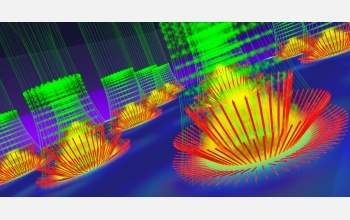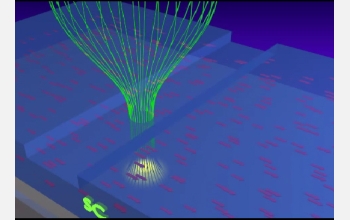All Images
News Release 05-071
A Super Job of Spin Control
Nanotechnology combined with superconductivity could pave the way for "spintronics"
This material is available primarily for archival purposes. Telephone numbers or other contact information may be out of date; please see current contact information at media contacts.

View Video
This animation gives an overview of the Janko group's proposal for controlling a "spintronic" device with superconductivity.
The idea is to create the device as a series of layers, each only a few dozen nanometers thick. At the bottom is a layer of diluted magnetic semiconductor (DMS) material--for example, gallium arsenide doped with manganese atoms. Each manganese atom contributes an extra electron to the material, and thus an extra electron spin. Above that is a layer of insulator (grey) and then a layer of superconducting material (SC).
Zooming in shows the magnetic field (green), which can thread through the superconducting layer only pinching itself down into an array of nanoscale flux tubes (green columns). The field in each flux tube is very intense, and extends right through the DMS layer. As it does, it forces a patch of electron spins to fall into line (red arrows). It also causes a certain amount of electric charge to accumulate (yellow).
Credit: Dr. Ovidiu Toader, University of Toronto

View Video
This animation shows a simple example of how spins could be manipulated with a superconducting layer. It shows just one magnetic flux tube, which moves in a nanoscale channel etched into the surface of the superconductor. When an electric current is sent through the superconductor (moving red arrows) the electromagnetic force moves the flux tube to one side. As it goes, it drags along the patch of spins it has created in the DMS layer underneath. When the current stops, the flux tube stays put. Likewise, a current flowing in the opposite direction moves the flux tube back to the other side.
Credit: Dr. Ovidiu Toader, University of Toronto


